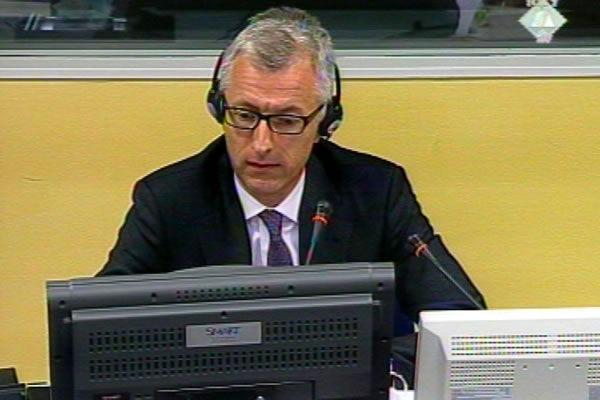Home
STRATEGIC GOALS ACHIEVED UNDER MLADIC’S COMMAND
The examination-in-chief of military and intelligence expert Reynaud Theunens continued at the trial of the former VRS Main Staff commander. Theunens presented his analysis of how the six Bosnian Serb strategic goals were accomplished through Ratko Mladic’s exercise of command and control
 Reynaud Theunens, witness at the Ratko Mladic trial
Reynaud Theunens, witness at the Ratko Mladic trial Prosecution military and intelligence expert Reynaud Theunens wrote an expert report on the role of Ratko Mladic as the VRS Main Staff commander. A section of his report is dedicated to the military goals pursued by Bosnian Serbs. The strategic goals were formulated at the 16th session of the Assembly of the Serbian Republic of Bosnia and Herzegovina Assembly on 12 May 1992.
According to Theunens, achieving the separation of the Serb people from the other two ethnic groups was a priority goal. The other goals defined the geographical boundaries of the planned Serb state with borders on the Neretva and Una rivers, the disappearance of the border on the Drina river, a corridor connecting Semberija and Krajina, a part of Sarajevo and access to the sea.
The strategic goals were the foundation for the establishment of the Serb state and served as a basis for VRS operations from 1992 to the end of 1995, Theunens explained. The Bosnian Serb forces, comprising the Territorial Defense, the police and volunteers from Serbia began implementing the goals even before they were officially articulated. By April and May 1992, the municipalities in the north of BH were taken. This allowed the creation of the corridor in Posavina at a later stage.
The prosecutor presented several orders showing that various measures aimed at accomplishing the strategic goals were indeed taken. At a meeting of the top Serb leadership on 6 June 1992, Mladic wrote down in his diary that Karadzic said ‘Bratunac is liberated’, ‘now Bratunac has fallen, Zvornik will fall too’ and ‘we hold half of Srebrenica’. In Theunens’s opinion, this shows the intent to accomplish the third goal – the elimination of the border on the Drina river – and the first goal, the separation of the ethnic communities. At the same meeting, Krajisnik called for the unification of northeastern Bosnia which would serve to accomplish the second goal, the creation of the Posavina corridor. Krajisnik concluded that ‘borders should be protected and defended, and tomorrow we will seize what is ours and stand ready to defend our state’. That same day, Mladic issued Directive 1 defining the future VRS operations.
According to the prosecutor, the orders he presented in court show that Mladic regularly exercised command and control. In April 1992, Mladic sought the transfer of personnel from the JNA 9th Corps to the police, and ordered that they be issued weapons and ammunition. Theunens concluded that Mladic thus ‘sidestepped’ the implementation of the Vance Plan in the so-called Republic of Serbian Krajina. According to the plan, the military units were to be disarmed and the police were to carry only sidearms. When Mladic took over as the commander of the Main Staff, he ordered the JNA units that were pulling out of BH to leave their weapons behind, the JNA soldiers born in BH to join the VRS and demanded regular reporting. All this shows that there was unified command and control in the units under his command, Theunens concluded.
Mladic showed great interest in Theunens’s evidence, and was cautioned several times by the presiding judge because he engaged in loud consultations with his defense. Theunens will continue his evidence in Mladic’s absence. Mladic has waived his right to attend the trial for undisclosed reasons.
Linked Reports
- Case : Mladic
- 2013-12-03 MLADIC WAS ACTIVE AND INFORMED COMMANDER
- 2013-12-02 ETHNIC DIVISION IN BH
- 2013-11-27 PROSECUTION COLLECTS EVIDENCE ON TOMASICA
- 2013-12-06 DIRECTIVES ISSUED BY ‘CHARISMATIC COMMANDER’
- 2013-12-09 DEFENSE CONTESTS EXPERTISE OF PROSECUTION’S WITNESS
- 2013-12-10 MLADIC’S ‘OSTENSIBLY GOOD INTENTIONS’
